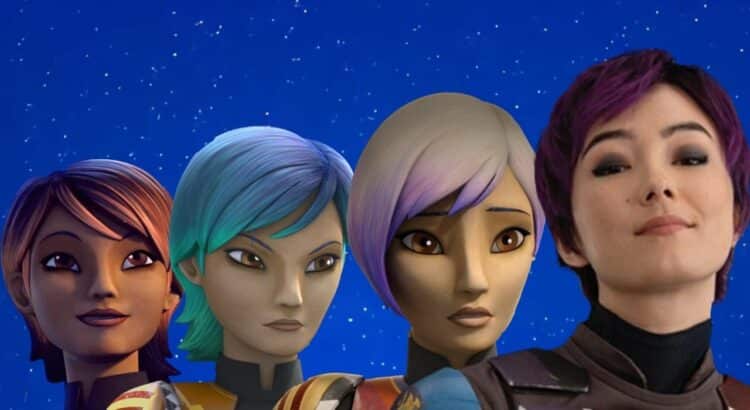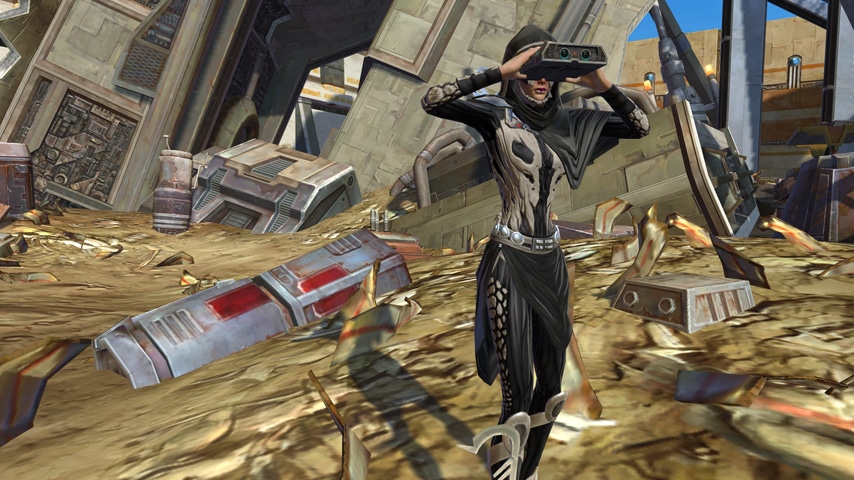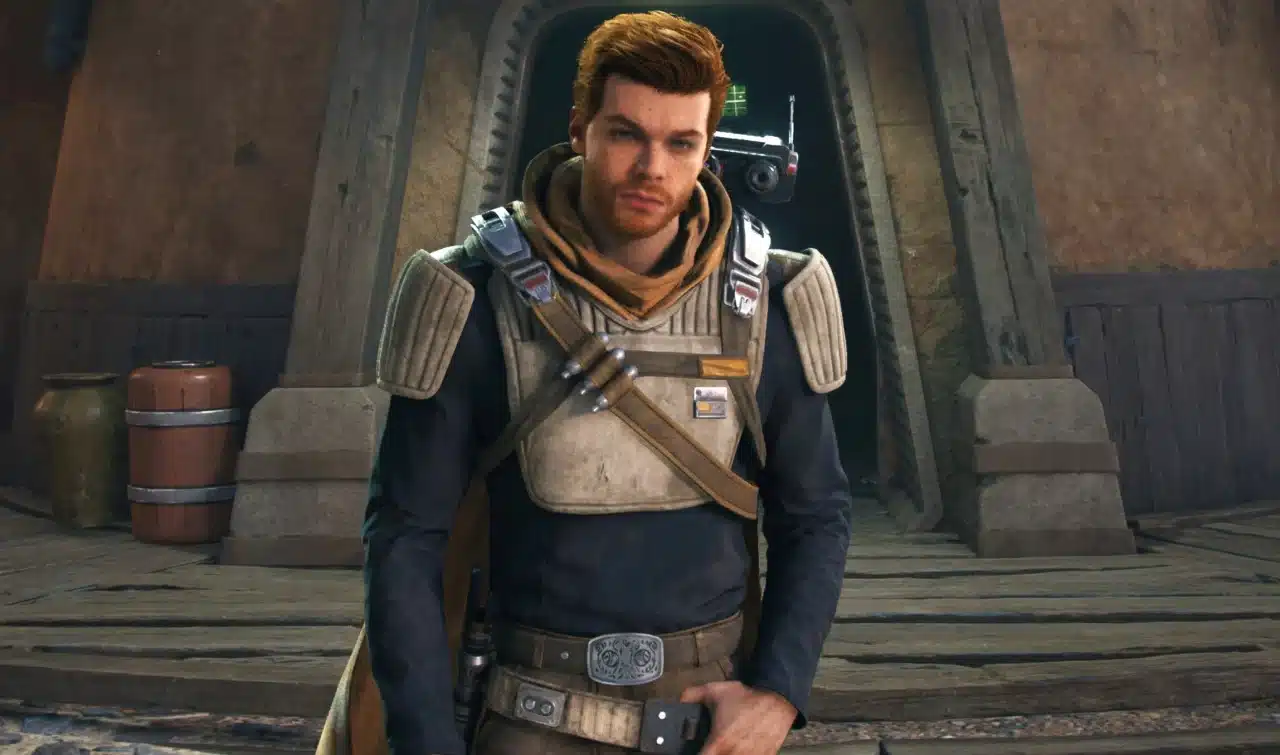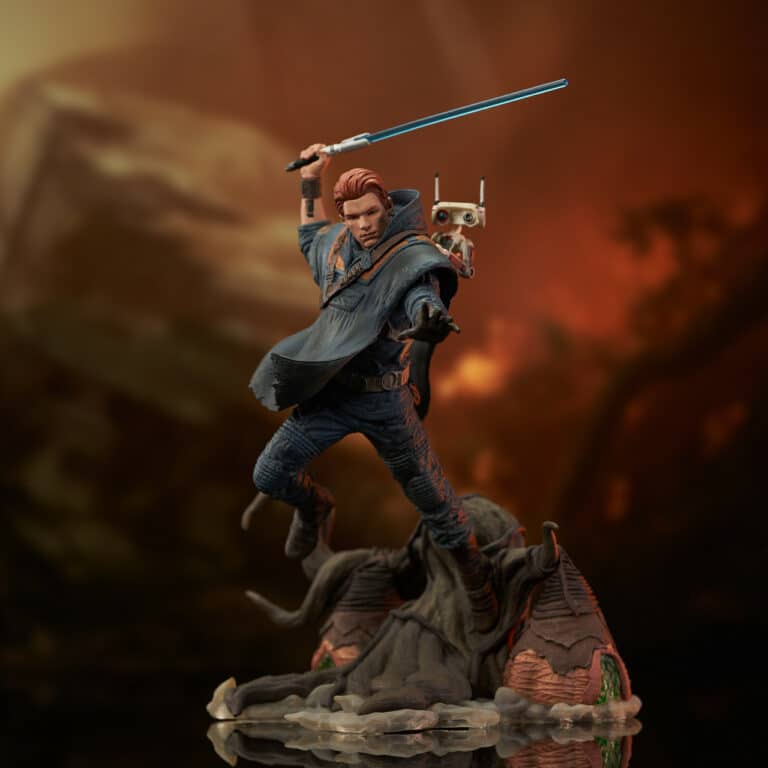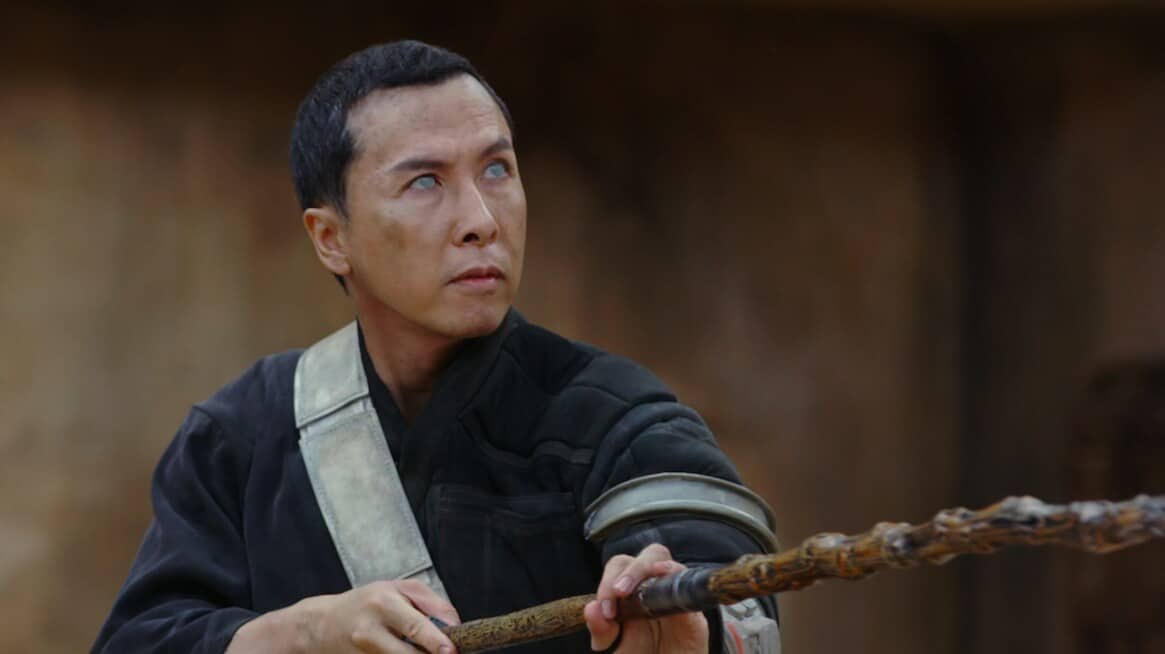Sabine Wren is one of the most complex and dynamic characters in Star Wars. First introduced in Star Wars: Rebels and later taking on a larger role in Ahsoka, she defies the traditional warrior archetype by blending Mandalorian combat skills with a rebellious flair for art. Throughout her journey, Sabine transitions from a young Mandalorian rebel to a leader who carries the weight of her people’s future. In Ahsoka, her story takes a new direction as she steps into the role of a Jedi-in-training, showing her willingness to constantly evolve and embrace new challenges.
Sabine’s story is one of transformation—she goes from battling the Empire as part of the Ghost crew to confronting her Mandalorian past and ultimately taking up the mantle of leadership. Along the way, she faces tough choices, inner conflicts, and an ever-present desire to redeem herself for her past. Her journey reflects the deeper themes of heritage, identity, and resilience that are core to Star Wars storytelling.
TL;DR: Sabine Wren’s journey from Mandalorian rebel in Star Wars: Rebels to Jedi-in-training in Ahsoka showcases her evolution from a warrior artist to a leader. Combining strength and creativity, Sabine embraces both her Mandalorian roots and the challenges of learning the Jedi way, symbolizing the merging of tradition and innovation in the fight for justice.
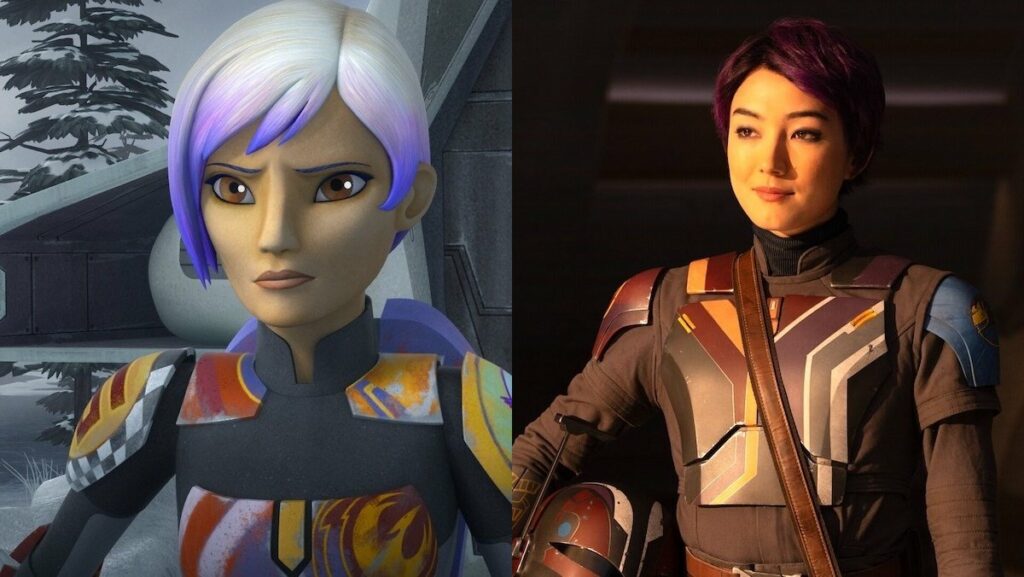
Chapter 1: Sabine Wren’s Origins – A Mandalorian with a Rebel Heart
Sabine Wren’s story begins in the fiery crucible of Mandalore, a planet known for its fierce warriors and turbulent political history. Born into Clan Wren, Sabine had the Mandalorian warrior culture instilled in her from a young age. But she wasn’t just another armor-clad fighter—Sabine had a rebellious spirit and a mind that pushed boundaries, blending her love of art with the intensity of combat.
As a teenager, Sabine was drawn into the Imperial Academy, where she showed incredible promise as a cadet. But unlike many, Sabine had a strong moral compass, and it didn’t take long for her to realize that the Empire was using her skills for more than just maintaining peace. In fact, she was being used to design weapons that would later oppress and harm her own people—an ethical nightmare for a young Mandalorian whose loyalty lay with family and honor, not tyranny.
When Sabine uncovered the truth about the Empire’s agenda, she did what any Mandalorian rebel with a love of graffiti and explosions would do: she left. And not quietly, either. Sabine’s defection from the Empire was explosive—literally—and left her on the run. This decision marked the beginning of her journey as a rebel, but also as a fugitive, hunted by the very regime she had once served.
This decision wasn’t just a physical escape, but a moral and emotional journey. Sabine was weighed down by guilt—not only for her own actions in helping create the Empire’s weapons but also for the harm those weapons would later inflict on her people. She carried that burden for a long time, which makes her eventual rise to Mandalorian leadership all the more compelling.
It was during this time that Sabine found her way to the Ghost crew—a ragtag group of rebels led by Hera Syndulla. Joining this crew was the perfect opportunity for Sabine to channel her frustration into something productive, aligning her natural rebellious streak with a cause worth fighting for. Not to mention, the crew gave her an outlet for her creative side. While most soldiers leave their mark with blaster shots, Sabine leaves vibrant graffiti wherever she goes. Her signature: spray-painted, colorful murals that stand as symbols of resistance against the Empire’s oppression.
What makes Sabine so unique is the way she blends her warrior culture with her artistic flair. Most Mandalorians are known for their stoic, battle-hardened demeanor, but Sabine adds a dash of color—both literally and figuratively. Her armor, for example, isn’t just functional; it’s an expression of who she is, adorned with bright colors and symbols of rebellion. In a galaxy full of grim warriors, Sabine’s personality and artistic vision make her stand out as a character who defies expectations.
Sabine’s artistic nature is not just a quirk—it’s a form of resistance. Her murals often carry deep messages of defiance against the Empire, and each piece she creates is a testament to the spirit of rebellion. In fact, her art is as much a weapon as her blasters or explosives, inspiring others to rise up against oppression. Sabine isn’t just fighting for freedom—she’s painting the way forward, one defiant splash of color at a time.
Despite being one of the youngest members of the Ghost crew, Sabine quickly establishes herself as an essential part of the team. Her Mandalorian combat skills, combined with her expertise in weapons and explosives, make her a formidable fighter. And while her bright personality and artistic talents might seem at odds with the intensity of war, Sabine’s ability to think creatively on the battlefield gives the crew a significant edge in their fight against the Empire.
But beneath her tough, vibrant exterior, Sabine is also a young woman grappling with guilt and the weight of her past decisions. Her journey in Rebels is not just about fighting the Empire, but about finding redemption for the role she played in helping them in the first place. This internal conflict adds depth to her character, showing that even the most rebellious and independent spirits are not immune to self-doubt and remorse.
In the end, Sabine’s origins highlight her complexity: she is a Mandalorian by birth, but a rebel by choice. Her journey from Imperial cadet to freedom fighter is marked by moments of intense struggle, creativity, and ultimately, leadership. Whether wielding a paintbrush or a blaster, Sabine Wren embodies the spirit of rebellion and resistance, making her one of the most intriguing characters in the Star Wars universe.
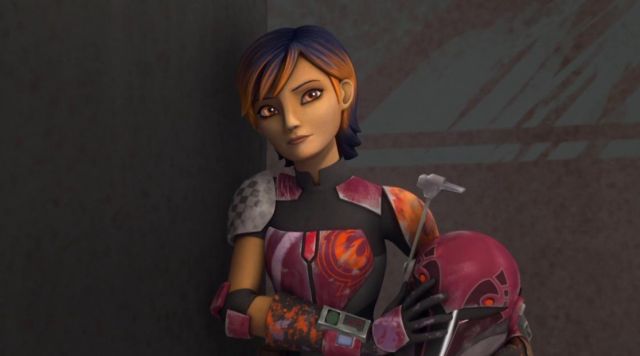
Chapter 2: The Journey in Star Wars: Rebels – From Rebel to Mandalorian Leader
Sabine Wren’s journey in Star Wars: Rebels is one of self-discovery, redemption, and ultimately, leadership. When we first meet her, Sabine is a crucial part of the Ghost crew—a ragtag team of rebels that consistently causes headaches for the Empire. Armed with her Mandalorian combat skills, explosives expertise, and artistic flair, Sabine proves herself to be a vital asset in the rebellion’s fight. But as the series progresses, it becomes clear that Sabine’s role in the galaxy is much bigger than just being the Ghost’s resident demolitions expert.
Sabine’s Internal Struggle: Guilt and Redemption
Throughout Rebels, one of the central themes in Sabine’s character arc is her internal struggle with guilt over her past. Sabine was once an Imperial cadet, a brilliant weapons designer who unwittingly contributed to the creation of devastating tools that the Empire used to oppress her own people. This guilt weighs heavily on Sabine, and much of her journey is about seeking redemption for her past actions. She isn’t just fighting the Empire for the sake of the galaxy—she’s fighting to make amends for her own mistakes.
This emotional burden comes to the forefront when Sabine reveals that she helped develop a weapon known as “The Duchess,” designed specifically to target Mandalorian armor. The Empire used this weapon against her people, devastating her homeworld and causing rifts within her family. Sabine’s sense of responsibility for this weapon drives her to take on more leadership roles, especially when she decides to fight back against the Empire’s control over Mandalore.
The Darksaber: A Symbol of Leadership
One of the defining moments in Sabine’s journey is when she discovers the Darksaber, an ancient Mandalorian weapon that carries immense symbolic weight. Whoever wields the Darksaber has the right to lead Mandalore, and it represents not just power, but the unity of the Mandalorian people. For Sabine, the Darksaber becomes both a literal and figurative burden. At first, she is reluctant to wield it, believing that she isn’t worthy of the responsibility that comes with it.
Her hesitation isn’t surprising. Sabine has spent years trying to distance herself from her Mandalorian heritage, preferring to focus on the fight against the Empire. But with the Darksaber in her hands, Sabine is forced to confront her past and the role she must play in the future of Mandalore. With guidance from Kanan Jarrus and Hera Syndulla, Sabine learns how to wield the Darksaber and, more importantly, how to embrace her destiny as a leader.
The Darksaber’s importance to Sabine’s arc cannot be overstated. It’s not just a cool weapon (though, let’s be real, it is extremely cool)—it’s a symbol of Sabine’s growth from rebellious teenager to Mandalorian leader. By accepting the Darksaber, Sabine steps up to take responsibility for uniting her people and fighting for Mandalore’s freedom.
Family, Duty, and the Mandalorian Struggle
A key element of Sabine’s development in Rebels is her complex relationship with her family. Mandalorians are known for their strong sense of loyalty and honor, but Sabine’s decision to abandon the Empire and later join the Rebellion caused a deep rift between her and her family. Her parents, who initially remained aligned with the Empire, saw her defection as a betrayal.
Reconnecting with her family is a significant part of Sabine’s arc, and it adds emotional depth to her character. When she returns to Mandalore, Sabine is forced to confront not only her past actions but also the expectations of her family and her people. Her journey becomes about more than just personal redemption—it’s about leading the Mandalorian people in a fight for freedom, not just from the Empire, but from their fractured loyalties.
In one of the most emotional moments of her story, Sabine’s family finally recognizes her bravery and leadership when she leads the charge to liberate Mandalore. It’s a moment of reconciliation for Sabine, as she earns the respect of her clan and begins to unite the Mandalorian people against the Empire’s oppression.
Sabine as a Leader: From Rebel to Mandalorian Icon
By the end of Rebels, Sabine Wren has evolved from a rebellious explosives expert to a true leader of her people. Her willingness to take up the Darksaber and lead the Mandalorian fight against the Empire marks her as a key figure in the Mandalorian legacy. However, Sabine’s leadership is not about conquest or personal power—it’s about protecting her people, restoring honor to Mandalore, and undoing the damage caused by the Empire.
Her journey from the rebellious teenager we first meet to the determined Mandalorian leader she becomes is a testament to her resilience, intelligence, and deep sense of responsibility. Sabine’s legacy in Rebels isn’t just about her prowess in battle—it’s about her ability to inspire those around her and bring hope to a fractured people.
In Star Wars: Rebels, Sabine Wren’s story becomes one of personal growth, family redemption, and the fight for Mandalorian freedom. Her evolution from a member of the Ghost crew to a leader of Mandalore is a powerful arc that showcases her strength, both as a warrior and as a symbol of Mandalorian pride. Sabine’s leadership is born from her unique ability to balance creativity, tactical skill, and deep emotional intelligence—qualities that set her apart as one of the most important Mandalorian figures in Star Wars lore.

Chapter 3: Sabine Wren in Ahsoka – A Jedi’s Journey?
Sabine Wren’s appearance in Ahsoka marks a significant shift in her character arc, as she steps into a role few could have anticipated: Jedi trainee. Yes, that’s right—our favorite Mandalorian rebel, known for her graffiti and explosives, is now dabbling with the Force. It’s an intriguing development that expands Sabine’s already complex character, blending her Mandalorian roots with the legacy of the Jedi. The question is: Can someone like Sabine, with no inherent Force sensitivity, really become a Jedi?
A Reluctant Apprentice
At the start of Ahsoka, we see a Sabine who is wrestling with her new path. Under the mentorship of Ahsoka Tano, Sabine begins training in the ways of the Jedi. But Sabine’s road to becoming a Jedi is not the smooth, predestined path we’ve seen with characters like Luke Skywalker or Anakin. Sabine’s journey is rough, full of doubt, frustration, and an ongoing struggle to reconcile her Mandalorian upbringing with the Jedi principles she’s learning. She’s not your typical Jedi-in-training, and that’s what makes her story so compelling.
Her struggles with patience and control are front and center, and it’s clear that Sabine’s natural instinct for action and combat—honed through years of Mandalorian training—clashes with the more introspective and peaceful nature of the Jedi. Sabine’s rebellious streak doesn’t just disappear overnight, and her reluctance to fully embrace the Jedi lifestyle adds layers to her growth as a character. Where most Jedi apprentices are taught to quiet their minds and find balance, Sabine is more comfortable with explosions, blasters, and direct action. This makes for a fascinating dynamic between her and Ahsoka, who embodies a more tempered, disciplined approach.
A Mandalorian Jedi?
The concept of Sabine, a Mandalorian, becoming a Jedi-in-training raises a few eyebrows in the Star Wars universe, and it’s easy to see why. Mandalorians and Jedi have historically been at odds, to put it lightly. Their cultures are practically polar opposites—Mandalorians value strength, combat prowess, and a warrior’s honor, while the Jedi focus on peace, diplomacy, and controlling emotions. Sabine trying to balance these two conflicting ideologies creates a tension that is both entertaining and deeply meaningful.
This blend of Mandalorian and Jedi traditions is something we haven’t seen before, and Sabine is at the heart of this unique crossover. She’s not Force-sensitive in the traditional sense, which makes her journey even more fascinating. Can someone without natural Force abilities really train to become a Jedi? Sabine challenges this long-held notion, raising questions about what it truly means to be a Jedi. Is it about inherent power, or is it about spirit, will, and determination? Sabine’s training with Ahsoka seems to be exploring these questions, hinting that maybe the Force is about more than just midichlorians.
The Ezra Bridger Connection
One of the driving forces behind Sabine’s journey in Ahsoka is her deep connection to Ezra Bridger, her close friend and fellow Rebel who disappeared at the end of Star Wars: Rebels. Sabine’s dedication to finding Ezra is a core element of her character arc, and it’s part of what motivates her to undergo Jedi training in the first place. It’s not just about becoming a Jedi for the sake of learning the ways of the Force—it’s about rescuing someone she deeply cares about.
Her bond with Ezra adds emotional depth to her quest. While Ahsoka trains Sabine in the Jedi ways, there’s always an undercurrent of urgency as Sabine longs to reunite with Ezra. Her connection to him is personal, and this personal motivation adds stakes to her Jedi training that go beyond the typical Jedi lessons of peace and harmony. For Sabine, the training is not just about spiritual growth—it’s about having the power to protect and save her friend.
Sabine’s Unique Path Forward
Sabine’s journey in Ahsoka represents a departure from the traditional Jedi narrative we’ve seen before. She’s not the chosen one, and she’s not a Force prodigy. Instead, Sabine’s story is about resilience, personal growth, and finding balance between two seemingly opposite parts of her identity—her Mandalorian warrior’s heart and the Jedi teachings of discipline and peace.
Her struggle is what makes her relatable. She’s not perfect, she makes mistakes, and she has doubts. But these qualities are what make Sabine such an enduring and dynamic character. Whether she ultimately becomes a full-fledged Jedi or finds another way to combine her Mandalorian heritage with her Jedi training, Sabine’s path is uniquely hers. And that’s what makes her journey in Ahsoka so compelling to watch.
In the end, Sabine Wren’s story in Ahsoka is about more than just becoming a Jedi—it’s about discovering who she truly is and what she’s capable of, regardless of the labels the galaxy might impose on her. Whether as a Mandalorian, a Jedi-in-training, or simply as Sabine, she’s a force to be reckoned with.
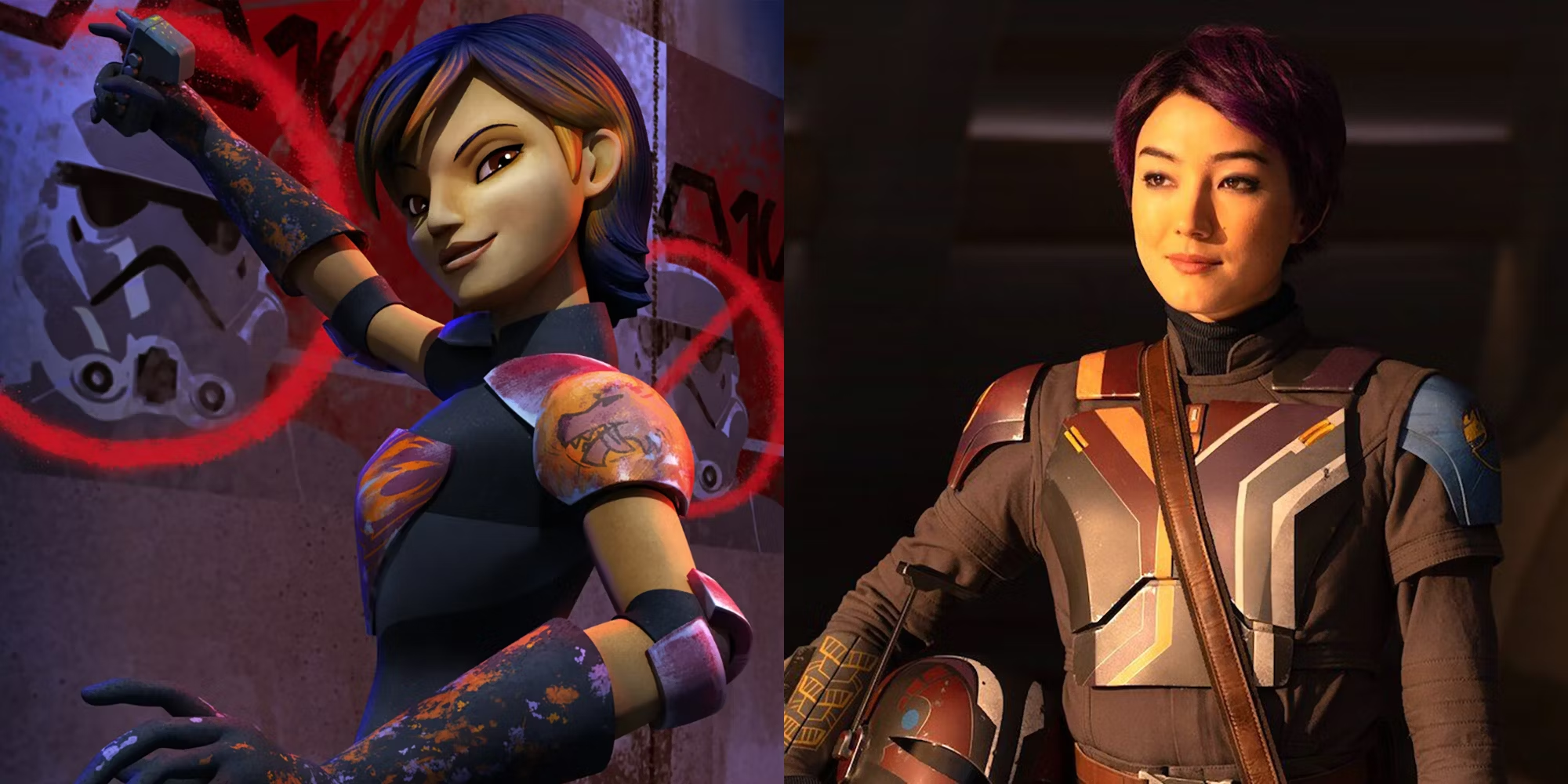
Chapter 4: Sabine Wren’s Legacy – A Symbol of Strength and Creativity
Sabine Wren’s legacy in the Star Wars universe is a blend of Mandalorian strength and unbridled creativity, making her one of the most dynamic characters in the galaxy. Unlike other warriors who focus solely on combat, Sabine has always wielded her artistic talents as an equally powerful weapon. Her graffiti isn’t just for decoration—it’s a symbol of defiance, hope, and the unyielding spirit of rebellion. Whether she’s painting a mural on the side of an Imperial TIE Fighter or leading a Mandalorian resistance, Sabine proves that creativity and strength can coexist in powerful ways.
The Art of Rebellion
From her introduction in Star Wars: Rebels, it’s clear that Sabine isn’t your typical Mandalorian warrior. Her armor is adorned with vibrant colors, and she leaves her artistic signature wherever she goes. For Sabine, art isn’t just a hobby—it’s a form of resistance. By decorating Imperial structures with graffiti and symbols of rebellion, Sabine turns her surroundings into a canvas of hope for those oppressed by the Empire.
In many ways, her art serves as a form of storytelling. Each mural, symbol, and painting carries the weight of the rebellion’s struggles, capturing the fight for freedom in a medium that speaks directly to the people. While blasters and explosives might damage the Empire’s resources, Sabine’s art inspires the hearts and minds of those fighting alongside her, turning every battle into a message that the Empire can’t snuff out creativity or the will to fight.
A Warrior Through and Through
While Sabine’s artistic side is central to her identity, it never overshadows her warrior spirit. As a Mandalorian, Sabine embodies the strength, honor, and combat prowess that comes with her heritage. She’s a master of multiple weapons, from her blasters to her customized Mandalorian armor. And let’s not forget her expertise with explosives—Sabine is the kind of character who can outsmart her enemies with sheer firepower or intricate traps. Her combat skills are second to none, whether she’s facing down a squad of stormtroopers or engaging in a full-on dogfight.
But Sabine isn’t just about brute force. As a leader, she understands the importance of strategy and teamwork. Her leadership of the Mandalorians during their rebellion against the Empire shows that she’s not only a capable fighter but also a tactician who can unite her people and inspire them to stand together. Sabine’s combination of strength and creativity has made her a formidable force in any battle she’s been part of.
Embracing Her Heritage
Sabine’s relationship with her Mandalorian heritage is a major part of her legacy. Early in Rebels, she struggles with guilt over her role in developing Imperial weapons and her family’s allegiance to the Empire. However, as her character evolves, she learns to embrace her heritage and take responsibility for Mandalore’s future. When she takes up the Darksaber, Sabine steps into the role of a leader, determined to unite the Mandalorian people and free them from the Empire’s grip.
Sabine’s journey to accepting the Darksaber’s responsibility is symbolic of her growth. She moves from being a rebellious teenager seeking atonement for her past to a confident leader who is ready to take on the future. Her legacy as a Mandalorian leader solidifies her place in the galaxy as someone who balances the weight of tradition with the need for progress.
A Character for the Ages
Sabine Wren’s legacy is one that will continue to inspire fans for generations. Her unique blend of art and combat skills breaks the mold of the typical warrior archetype, showing that strength comes in many forms. Sabine’s story, from her days with the Ghost crew to her evolving role in Ahsoka, illustrates the power of embracing all aspects of oneself—whether it’s through creative expression or through wielding a Darksaber.
More than just a fighter, Sabine’s creative soul and rebellious spirit make her one of the most compelling characters in the Star Wars saga. Her journey is a reminder that being a hero isn’t about fitting into a mold but about using your unique talents to make the galaxy a better place. Whether she’s creating vibrant graffiti or leading Mandalorians into battle, Sabine Wren’s legacy as a symbol of strength and creativity is secure in the stars.
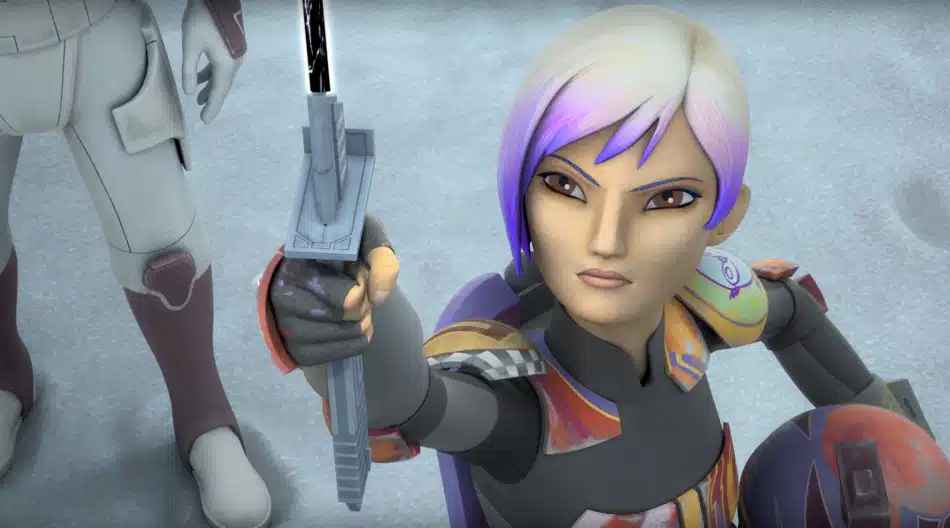
Conclusion: Sabine Wren – A Warrior, Artist, and Leader in Her Own Right
Sabine Wren’s journey through Star Wars: Rebels and Ahsoka showcases her growth from a rebellious Mandalorian teen to a symbol of leadership and creativity in the galaxy. In Rebels, Sabine wrestled with her past while embracing her Mandalorian heritage, ultimately taking up the Darksaber and uniting her people. Her artistic rebellion, reflected in everything from her graffiti to her battle tactics, made her a unique and unconventional hero.
In Ahsoka, we see Sabine taking another unexpected step in her evolution—training as a Jedi under Ahsoka Tano. Although not traditionally Force-sensitive, Sabine’s journey as a Jedi-in-training pushes her to reconcile her Mandalorian roots with the discipline of the Jedi. It highlights her resilience and determination to protect those she cares about, particularly in her search for Ezra Bridger.
Throughout both series, Sabine’s legacy is a mix of art, strategy, and leadership. She redefines what it means to be a hero, showing that strength isn’t just physical but also comes from creativity, loyalty, and a fierce desire for justice. Whether wielding the Darksaber, crafting intricate weapons, or painting vibrant symbols of resistance, Sabine proves that true leadership and heroism can come in many forms.
Her journey isn’t about following a set path, but about forging her own—one where tradition and innovation coexist. In this way, Sabine Wren’s story transcends her role as a Mandalorian or a Rebel and establishes her as a character who inspires others to fight for their beliefs, embrace their individuality, and find strength in both heritage and innovation. As Sabine continues to grow, her legacy in the Star Wars universe will remain one of boldness, creativity, and unwavering resolve.


